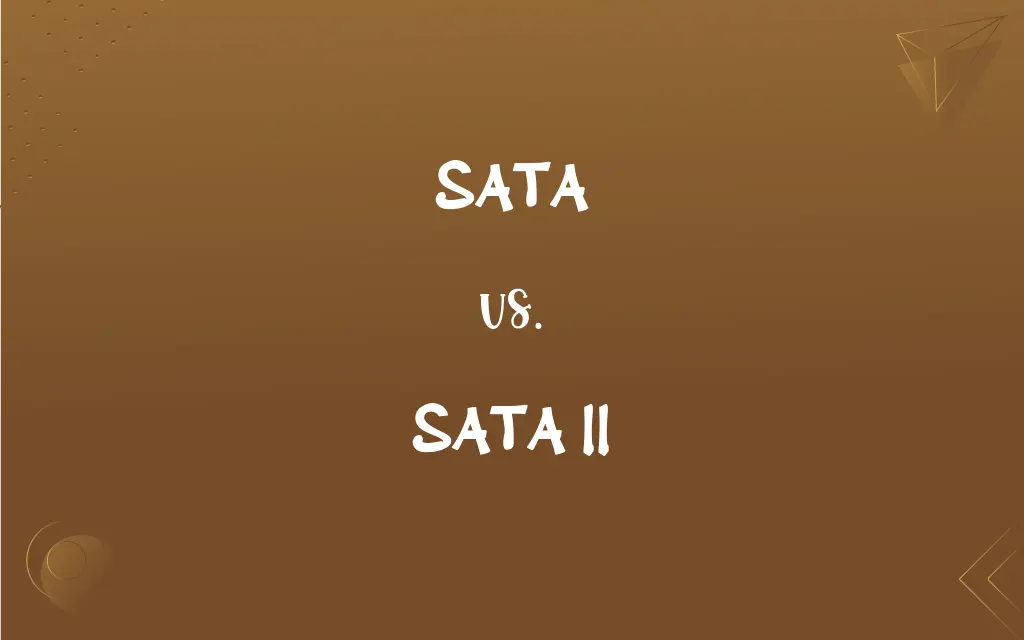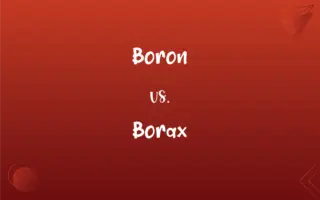SATA vs. SATA II: What's the Difference?
Edited by Aimie Carlson || By Janet White || Published on January 14, 2024
SATA, or Serial ATA, is a computer bus interface for connecting storage devices, while SATA II, also known as SATA 3Gb/s, is an improved version offering higher transfer rates compared to the original SATA.

Key Differences
SATA, standing for Serial Advanced Technology Attachment, is a standard for connecting and transferring data from hard disk drives to computer systems. SATA II, an evolution of the original SATA, doubles the data transfer rate from 1.5 Gb/s to 3 Gb/s, enhancing performance for storage devices.
In SATA technology, the data cable has seven conductors and operates at a lower voltage, reducing cable size and cost. SATA II retains the same cable design but improves data encoding efficiency, offering better performance with the same physical infrastructure.
SATA supports hot-swapping, enabling users to change drives without shutting down the system. SATA II extends this capability with features like native command queuing (NCQ), significantly improving drive performance and efficiency in multitasking environments.
The original SATA interface was primarily aimed at consumer-level hard drives. SATA II, while maintaining compatibility with SATA, was designed to cater to more demanding applications, including servers and high-performance computing.
SATA provides a straightforward upgrade path from older ATA technology, offering better scalability and easier integration. SATA II builds upon this, ensuring backward compatibility while providing a higher speed interface for newer storage devices.
ADVERTISEMENT
Comparison Chart
Data Transfer Rate
1.5 Gb/s
3 Gb/s
Cable Design
7-conductor data cable
Same as SATA
Features
Hot-swapping
Hot-swapping, NCQ
Target Applications
Consumer-level drives
High-performance drives
Upgrade Path
From ATA
From SATA
ADVERTISEMENT
SATA and SATA II Definitions
SATA
SATA cables are thinner and more flexible than PATA cables.
The thin SATA cables made it easier to manage the wiring inside my PC case.
SATA II
SATA II is ideal for high-performance applications like gaming and servers.
For my gaming setup, I chose a hard drive that supports SATA II.
SATA
SATA has a lower pin count than its predecessor, simplifying the connection.
The 7-pin SATA connector is much simpler than the older 40-pin interface.
SATA II
SATA II supports features like native command queuing for better multitasking.
The NCQ feature in SATA II helps in efficient data handling during heavy loads.
SATA
SATA allows for faster data transfer compared to PATA.
Upgrading to SATA significantly improved my computer's disk read and write speeds.
SATA II
SATA II, an advancement of SATA, offers higher data transfer rates up to 3 Gb/s.
My new SSD benefits from the increased speed of the SATA II interface.
SATA
SATA is a computer bus interface for connecting storage devices to a motherboard.
My new hard drive uses a SATA connection for data transfer.
SATA II
SATA II maintains backward compatibility with SATA, ensuring a broader range of use.
Despite having a SATA II port, I can still use my older SATA hard drive.
SATA
SATA supports hot-swapping, enabling users to replace drives without powering down.
I replaced the faulty drive with a new one thanks to SATA's hot-swapping feature.
SATA II
SATA II retains the same physical connector as SATA, ensuring ease of integration.
I didn't need new cables when upgrading to a SATA II drive.
FAQs
Is SATA II faster than SATA?
Yes, SATA II has double the data transfer rate of SATA.
What does SATA II offer over SATA?
SATA II offers higher data transfer rates of up to 3 Gb/s and features like NCQ for better performance.
What is SATA?
SATA is a computer bus interface used for connecting storage devices like hard drives to a motherboard.
Can I use a SATA II drive on a SATA interface?
Yes, SATA II drives are backward compatible with SATA interfaces.
Does SATA II support hot-swapping?
Yes, like SATA, SATA II also supports hot-swapping.
Are SATA and SATA II connectors the same?
Yes, they have the same physical connectors, ensuring compatibility.
Is SATA better than PATA?
Yes, SATA offers faster data transfer rates and more efficient cable management than PATA.
Are SATA cables more flexible than PATA cables?
Yes, SATA cables are thinner and more flexible than PATA cables.
Is data recovery easier with SATA or SATA II drives?
Data recovery depends on the drive's condition, not the interface type.
Can SATA II be used for SSDs?
Yes, SATA II can be used for SSDs and offers improved performance over SATA.
Is it worth upgrading from SATA to SATA II?
Upgrading to SATA II is beneficial for higher data transfer rates, especially for SSDs or high-performance tasks.
What is the maximum cable length for SATA?
The maximum cable length for SATA is 1 meter.
What kind of devices use SATA interfaces?
SATA interfaces are commonly used in hard drives and optical drives.
What does NCQ in SATA II do?
NCQ allows for efficient handling of multiple simultaneous read/write requests.
Can I use a SATA II cable with a SATA drive?
Yes, SATA and SATA II cables are interchangeable.
Do SATA and SATA II support RAID configurations?
Yes, both support RAID configurations for enhanced performance and redundancy.
Is SATA II suitable for server use?
Yes, SATA II's higher performance makes it suitable for server applications.
What is the pin count for SATA connectors?
SATA connectors have 7 pins.
Does SATA II require more power than SATA?
No, SATA II doesn't necessarily require more power than SATA.
Can SATA be used for external drives?
Yes, with an appropriate enclosure, SATA can be used for external drives.
About Author
Written by
Janet WhiteJanet White has been an esteemed writer and blogger for Difference Wiki. Holding a Master's degree in Science and Medical Journalism from the prestigious Boston University, she has consistently demonstrated her expertise and passion for her field. When she's not immersed in her work, Janet relishes her time exercising, delving into a good book, and cherishing moments with friends and family.
Edited by
Aimie CarlsonAimie Carlson, holding a master's degree in English literature, is a fervent English language enthusiast. She lends her writing talents to Difference Wiki, a prominent website that specializes in comparisons, offering readers insightful analyses that both captivate and inform.






































































